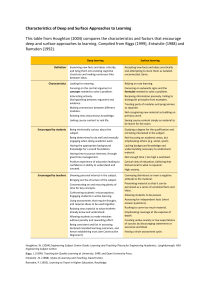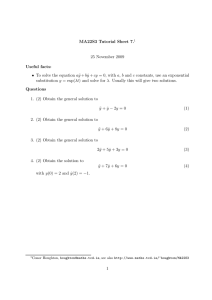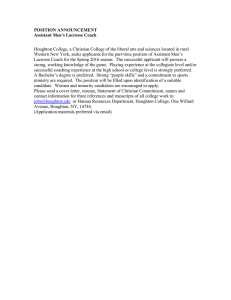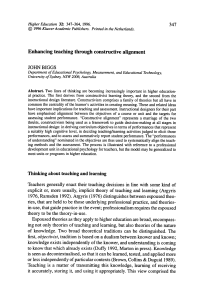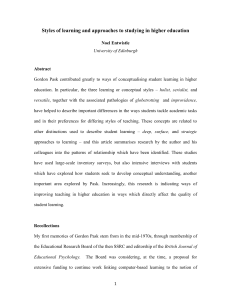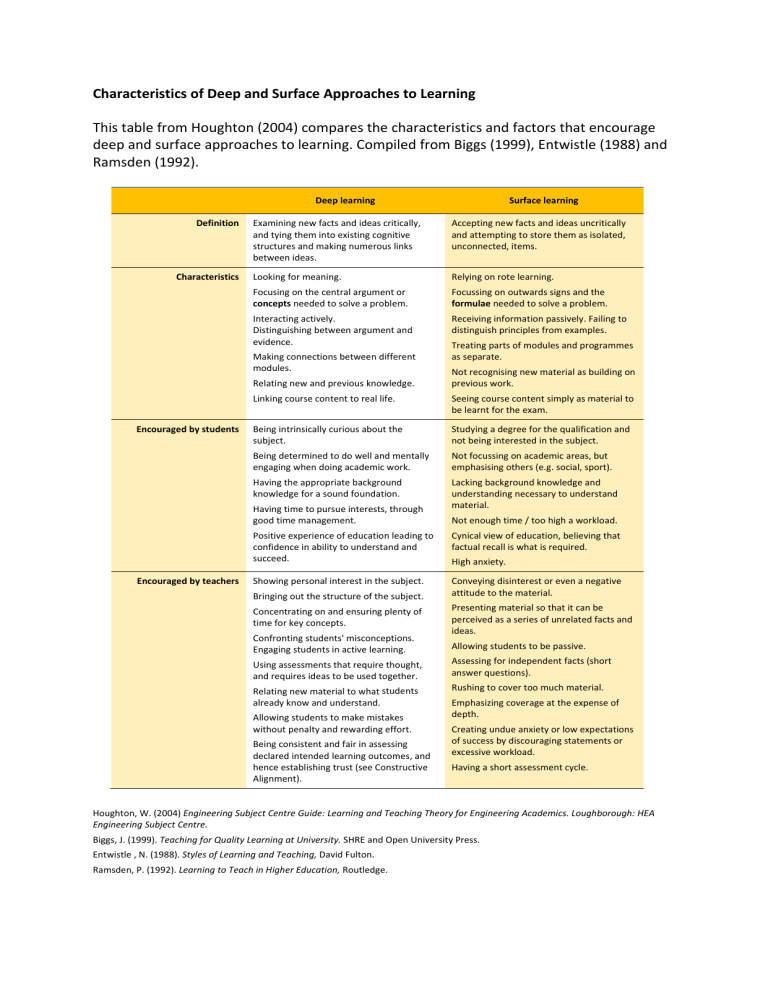
Characteristics of Deep and Surface Approaches to Learning This table from Houghton (2004) compares the characteristics and factors that encourage deep and surface approaches to learning. Compiled from Biggs (1999), Entwistle (1988) and Ramsden (1992). Deep learning Definition Characteristics Examining new facts and ideas critically, and tying them into existing cognitive structures and making numerous links between ideas. Accepting new facts and ideas uncritically and attempting to store them as isolated, unconnected, items. Looking for meaning. Relying on rote learning. Focusing on the central argument or concepts needed to solve a problem. Focussing on outwards signs and the formulae needed to solve a problem. Interacting actively. Distinguishing between argument and evidence. Receiving information passively. Failing to distinguish principles from examples. Making connections between different modules. Relating new and previous knowledge. Encouraged by students Treating parts of modules and programmes as separate. Not recognising new material as building on previous work. Linking course content to real life. Seeing course content simply as material to be learnt for the exam. Being intrinsically curious about the subject. Studying a degree for the qualification and not being interested in the subject. Being determined to do well and mentally engaging when doing academic work. Not focussing on academic areas, but emphasising others (e.g. social, sport). Having the appropriate background knowledge for a sound foundation. Lacking background knowledge and understanding necessary to understand material. Having time to pursue interests, through good time management. Encouraged by teachers Surface learning Not enough time / too high a workload. Positive experience of education leading to confidence in ability to understand and succeed. Cynical view of education, believing that factual recall is what is required. Showing personal interest in the subject. Conveying disinterest or even a negative attitude to the material. Bringing out the structure of the subject. Concentrating on and ensuring plenty of time for key concepts. Confronting students' misconceptions. Engaging students in active learning. High anxiety. Presenting material so that it can be perceived as a series of unrelated facts and ideas. Allowing students to be passive. Using assessments that require thought, and requires ideas to be used together. Assessing for independent facts (short answer questions). Relating new material to what students already know and understand. Rushing to cover too much material. Allowing students to make mistakes without penalty and rewarding effort. Being consistent and fair in assessing declared intended learning outcomes, and hence establishing trust (see Constructive Alignment). Emphasizing coverage at the expense of depth. Creating undue anxiety or low expectations of success by discouraging statements or excessive workload. Having a short assessment cycle. Houghton, W. (2004) Engineering Subject Centre Guide: Learning and Teaching Theory for Engineering Academics. Loughborough: HEA Engineering Subject Centre. Biggs, J. (1999). Teaching for Quality Learning at University. SHRE and Open University Press. Entwistle , N. (1988). Styles of Learning and Teaching, David Fulton. Ramsden, P. (1992). Learning to Teach in Higher Education, Routledge.
